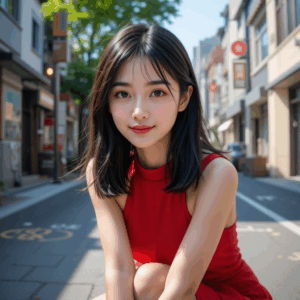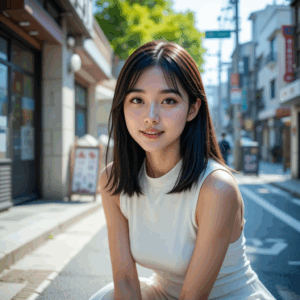Exploring the realm of AI-Generated Women in Beauty, this article delves into the innovative use of artificial intelligence to shape beauty standards. With a blend of informative content and engaging storytelling, readers are invited to ponder the future implications of AI-generated beauty.
Providing insights into the criteria used to rank AI-generated women and the ethical considerations surrounding their existence, this piece aims to spark meaningful discussions on the evolving landscape of beauty standards.
 AI-generated women in the beauty industry are virtual representations of women created using artificial intelligence technology. These digital models are designed to showcase different beauty trends, makeup styles, skincare products, and hair looks without the need for human models. The role of AI in creating these virtual women is to provide a realistic and customizable platform for beauty brands to showcase their products and services to consumers.
The impact of AI-generated women on the beauty industry is significant, as it revolutionizes the way companies market their products and engage with their target audience in the digital age.
.
AI-generated women in the beauty industry are virtual representations of women created using artificial intelligence technology. These digital models are designed to showcase different beauty trends, makeup styles, skincare products, and hair looks without the need for human models. The role of AI in creating these virtual women is to provide a realistic and customizable platform for beauty brands to showcase their products and services to consumers.
The impact of AI-generated women on the beauty industry is significant, as it revolutionizes the way companies market their products and engage with their target audience in the digital age.
.
 AI technology has played a significant role in reshaping and evolving beauty standards in society. By analyzing the data and creating AI-generated women, the concept of beauty has been redefined in various ways. Let's delve deeper into how AI has influenced the evolution of beauty standards:
AI technology has played a significant role in reshaping and evolving beauty standards in society. By analyzing the data and creating AI-generated women, the concept of beauty has been redefined in various ways. Let's delve deeper into how AI has influenced the evolution of beauty standards:
 In conclusion, the journey through the world of AI-Generated Women Ranked sheds light on the intricate relationship between technology and beauty. As we navigate the ethical implications and evolving standards, one question remains - is this the future of beauty?
In conclusion, the journey through the world of AI-Generated Women Ranked sheds light on the intricate relationship between technology and beauty. As we navigate the ethical implications and evolving standards, one question remains - is this the future of beauty?
Introduction to AI-Generated Women in Beauty
 AI-generated women in the beauty industry are virtual representations of women created using artificial intelligence technology. These digital models are designed to showcase different beauty trends, makeup styles, skincare products, and hair looks without the need for human models. The role of AI in creating these virtual women is to provide a realistic and customizable platform for beauty brands to showcase their products and services to consumers.
The impact of AI-generated women on the beauty industry is significant, as it revolutionizes the way companies market their products and engage with their target audience in the digital age.
AI-generated women in the beauty industry are virtual representations of women created using artificial intelligence technology. These digital models are designed to showcase different beauty trends, makeup styles, skincare products, and hair looks without the need for human models. The role of AI in creating these virtual women is to provide a realistic and customizable platform for beauty brands to showcase their products and services to consumers.
The impact of AI-generated women on the beauty industry is significant, as it revolutionizes the way companies market their products and engage with their target audience in the digital age.
Role of AI in Creating Virtual Women
AI technology uses algorithms to analyze and replicate human features, allowing for the creation of realistic virtual women for beauty purposes. By leveraging AI, beauty brands can customize these digital models to reflect diverse beauty standards, cater to different demographics, and experiment with new trends and styles in real-time. This innovative approach not only saves time and resources but also offers a more personalized and interactive experience for consumers in the beauty industry.Impact of AI-Generated Women on the Beauty Industry
- Enhanced Product Visualization: AI-generated women enable beauty brands to showcase their products in a more visually appealing and dynamic way, allowing consumers to see how different makeup looks or skincare routines would appear on them.
- Personalized Beauty Experiences: By using AI technology to create virtual women, beauty companies can offer personalized recommendations, tutorials, and virtual try-on experiences tailored to individual preferences and needs.
- Diversity and Inclusivity: AI-generated women can help promote diversity and inclusivity in the beauty industry by representing a wide range of skin tones, body types, and beauty aesthetics that resonate with a broader audience.
- Innovative Marketing Strategies: The use of AI-generated women opens up new possibilities for creative marketing campaigns, collaborations with influencers, and interactive brand experiences that drive consumer engagement and loyalty.
Ranking Criteria for AI-Generated Women
When it comes to ranking AI-generated women in beauty, several factors are considered to determine beauty standards. These criteria play a significant role in shaping the perception of beauty in the digital realm.Facial Symmetry and Proportion
Facial symmetry and proportion are crucial criteria used to evaluate AI-generated beauty standards. The algorithm analyzes features like the distance between the eyes, the shape of the nose, and the symmetry of the face to determine attractiveness.Skin Clarity and Texture
Skin clarity and texture are also important factors in ranking AI-generated women. The algorithm assesses the smoothness of the skin, the presence of blemishes, and overall skin quality to determine beauty standards.Hair Quality and Style
The quality and style of hair are key criteria in evaluating AI-generated beauty. Factors such as hair texture, color, length, and style are taken into account to determine the attractiveness of the digital avatar.Expression and Emotion
Expression and emotion play a significant role in ranking AI-generated women. The algorithm analyzes facial expressions, eye contact, and emotions conveyed to assess the overall appeal of the digital avatar.Overall Harmony and Balance
The overall harmony and balance of features are essential criteria in determining beauty standards for AI-generated women. The algorithm looks at how all the facial features come together to create a harmonious and balanced appearanceEthical Implications of AI-Generated Beauty
As technology advances, the use of AI-generated women in beauty raises various ethical considerations that need to be carefully examined.Societal Impact of Promoting AI-Generated Beauty Standards
The promotion of AI-generated beauty standards can have significant societal impacts, influencing how individuals perceive beauty and setting unrealistic expectations.- AI-generated beauty may perpetuate unattainable standards, leading to increased pressure on individuals to conform to artificial ideals.
- It may contribute to a lack of diversity and representation in beauty standards, reinforcing narrow definitions of beauty.
- Individuals may start to compare themselves to AI-generated images, impacting self-esteem and body image.
Implications of AI-Generated Beauty on Self-Image and Confidence
The rise of AI-generated beauty can have profound implications on how individuals view themselves and their self-worth.- Constant exposure to flawless AI-generated images may distort perceptions of real beauty, leading to dissatisfaction with one's appearance.
- Individuals may feel pressured to alter their physical features to match AI-generated beauty standards, risking their mental and physical well-being.
- The reliance on AI-generated beauty as a benchmark for attractiveness can erode self-confidence and foster insecurities.
Evolution of Beauty Standards through AI
 AI technology has played a significant role in reshaping and evolving beauty standards in society. By analyzing the data and creating AI-generated women, the concept of beauty has been redefined in various ways. Let's delve deeper into how AI has influenced the evolution of beauty standards:
AI technology has played a significant role in reshaping and evolving beauty standards in society. By analyzing the data and creating AI-generated women, the concept of beauty has been redefined in various ways. Let's delve deeper into how AI has influenced the evolution of beauty standards:
Comparison of Traditional vs. AI-Influenced Beauty Standards
When comparing traditional beauty standards with those influenced by AI-generated beauty, we see a shift towards a more diverse and inclusive definition of beauty. While traditional standards often focused on specific physical attributes like symmetry and clear skin, AI-generated beauty celebrates a wider range of features, including unique facial structures and unconventional characteristics. This shift has challenged the conventional norms of beauty and encouraged acceptance of individuality in appearance.Impact of AI on Perceptions of Beauty
AI has not only reshaped beauty standards but also redefined perceptions of beauty in society. By showcasing AI-generated women with varying appearances and characteristics, people are exposed to a more diverse representation of beauty. This exposure has led to a broader acceptance of different standards of beauty, promoting inclusivity and breaking away from rigid beauty ideals. As a result, society's perception of beauty has become more fluid and open to embracing uniqueness in all its forms.Closing Summary
 In conclusion, the journey through the world of AI-Generated Women Ranked sheds light on the intricate relationship between technology and beauty. As we navigate the ethical implications and evolving standards, one question remains - is this the future of beauty?
In conclusion, the journey through the world of AI-Generated Women Ranked sheds light on the intricate relationship between technology and beauty. As we navigate the ethical implications and evolving standards, one question remains - is this the future of beauty?










